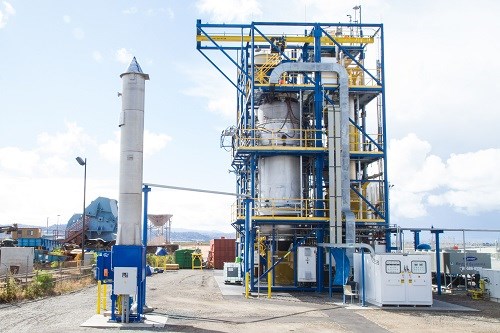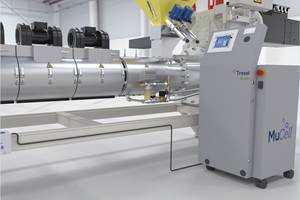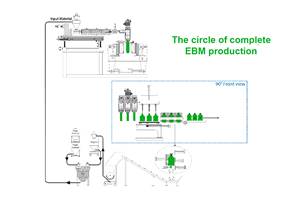'Clean, Sustainable' Carbon Black Production On Our Shores
Monolith's carbon black process, which uses natural gas as feedstock, will now be applied to a full-scale manufacturing facility in Nebraska.

Throughout most of the 20th century, North America was the leading producer of carbon black. By 2012, North American capacity had dropped to a mere 12% of the global capacity, while China’s had risen to 38%. One company is looking to shift the production of carbon black from being less reliant on the utilization of petroleum oil; first, in the domestic market and then globally. In fact, (formerly Boxer Industries) believes that its proprietary process technology has the potential to reestablish North America as the leading global producer of carbon black.
The Redwood City, California firm produces both standard ASTM grades of carbon black as well as highly customized performance grades for a broad range of applications. In plastics alone, these range from colorants in consumer and industrial goods to UV absorbers in pipe and agricultural films to electrically conductive grades used in electrical cables and various components of high-volume consumer electronics. Carbon blacks have long been used as reinforcing agents and fillers in tires and other rubber products, batteries, and as pigments in inks, paints and toner.
Monolith uses natural gas as feedstock in its process instead of crude oil or coal-tar as in conventional processes. Since mid-2014, the company has been operating a pilot plant using its technology to convert pipeline grade natural gas using grid electricity into valuable carbon black and hydrogen. Located at its Redwood City site, the Seaport Plant serves as Monolith’s industrial demonstration facility and represents the first new carbon black plant to be permitted and build in the U.S. in the past 30 years, because of environmental regulations. On-site lab facilities also allow for grade evaluation and tuning, as well as ongoing applications development.
As noted above, a coproduct of Monolith’s manufacturing process is plentiful hydrogen. This valuable industrial gas is used in a range of industries including petroleum refining, clean-power generation, and chemicals. It was this that led to Monolith establishing what appears to be a first-of-its-kind partnership with the Nebraska Public Power District (NPPD), Nebraska’s largest electric utility. NPPD plans to replace an existing coal-fired boiler at its Sheldon Station plant in Hallam, Nebraska with one that will use hydrogen, produced by Monolith’s new full-scale carbon black manufacturing facility, to generate electricity.
Construction of Monolith’s facility is commencing this year, with initial production capacity scheduled online in 2016, and full production capacity on line in 2019. It is being build adjacent to the Sheldon Station so NPPD can easily access the hydrogen. When burned, the hydrogen fuel produces zero greenhouse gas emissions. Through this collaborative project, NPPD is expected to reduce CO2 emissions at Sheldon Station by 1.1 million tons/yr. The new boiler, using hydrogen as a fuel, will continue to be capable of generating 125 megawatts of electricity for NPPD’s customers. The conversion is also expected to result in a dramatic reduction in other types of air emissions, and also aid in NPPD’s maintaining service as a low-cost energy producer.
The facility will result in hundreds of new high-tech manufacturing jobs in that region. In their joint announcement, Pat Pope, president and CEO of NPPD noted that the Sheldon Station has always been “a place of firsts”—the first nuclear plant in Nebraska and now the first utility-scale hydrogen powered generator. Said Monolith’s co-founder and CCO Robert Hanson, “Together, Monolith and NPPD are helping reduce pollution, while still adding jobs and maintaining energy production. Additionally, Monolith is bringing the first cleanly made carbon black plant to the U.S., which will help our country grow this important industry and expand America’s manufacturing economy.”
Related Content
Foam-Core Multilayer Blow Molding: How It’s Done
Learn here how to take advantage of new lightweighting and recycle utilization opportunities in consumer packaging, thanks to a collaboration of leaders in microcellular foaming and multilayer head design.
Read MoreMedical Tubing: Use Simulation to Troubleshoot, Optimize Processing & Dies
Extrusion simulations can be useful in anticipating issues and running “what-if” scenarios to size extruders and design dies for extrusion projects. It should be used at early stages of any project to avoid trial and error and remaking tooling.
Read MorePHA Compound Molded into “World’s First” Biodegradable Bottle Closures
Beyond Plastic and partners have created a certified biodegradable PHA compound that can be injection molded into 38-mm closures in a sub 6-second cycle from a multicavity hot runner tool.
Read MoreGet Color Changes Right In Extrusion Blow Molding
Follow these best practices to minimize loss of time, material and labor during color changes in molding containers from bottles to jerrycans. The authors explore what this means for each step of the process, from raw-material infeed to handling and reprocessing tails and trim.
Read MoreRead Next
For PLASTICS' CEO Seaholm, NPE to Shine Light on Sustainability Successes
With advocacy, communication and sustainability as three main pillars, Seaholm leads a trade association to NPE that ‘is more active today than we have ever been.’
Read MoreSee Recyclers Close the Loop on Trade Show Production Scrap at NPE2024
A collaboration between show organizer PLASTICS, recycler CPR and size reduction experts WEIMA and Conair recovered and recycled all production scrap at NPE2024.
Read MoreLead the Conversation, Change the Conversation
Coverage of single-use plastics can be both misleading and demoralizing. Here are 10 tips for changing the perception of the plastics industry at your company and in your community.
Read More














